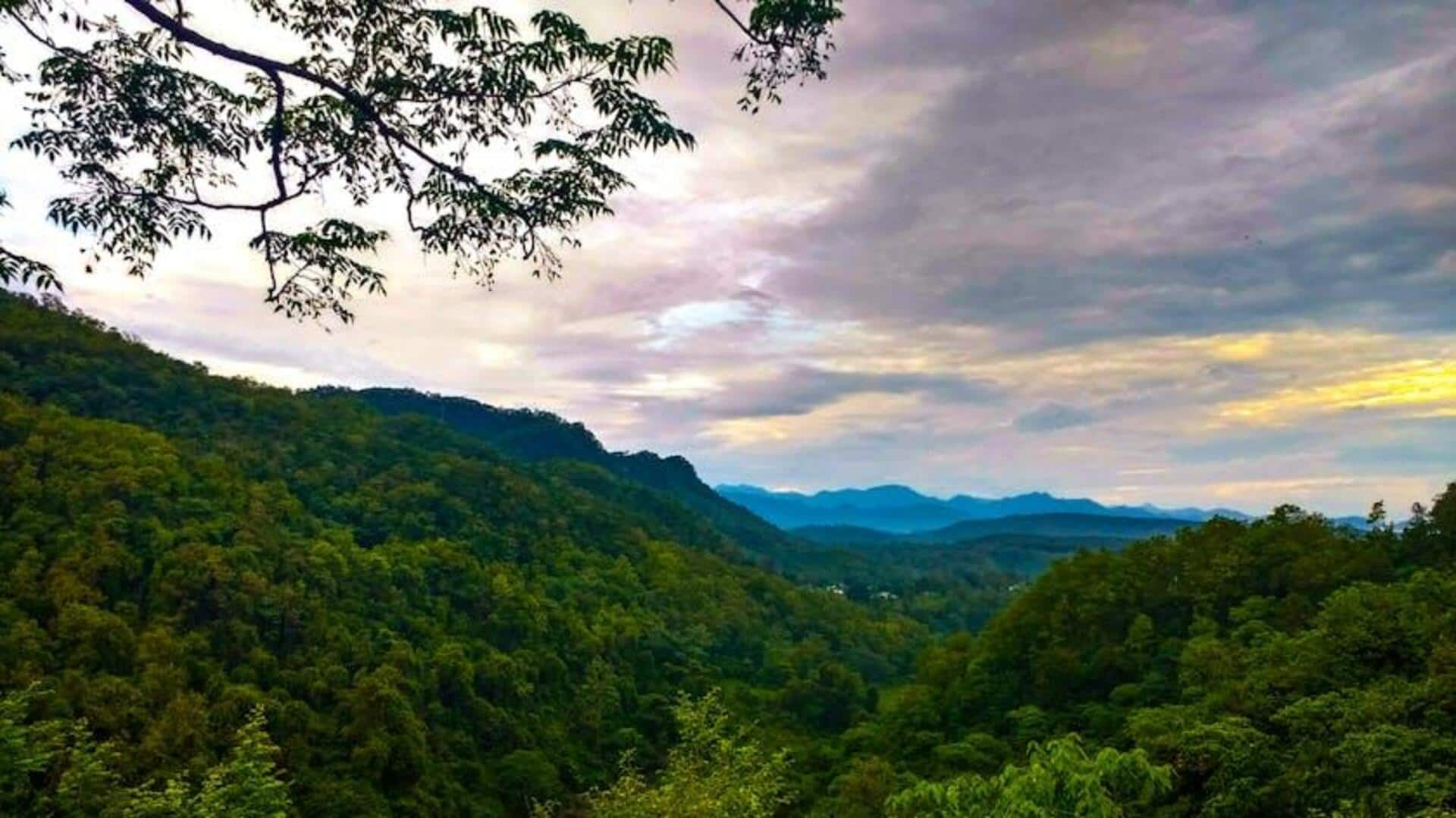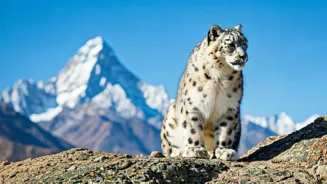Snow Leopard: The Ghost
One of the most elusive creatures in the Himalayas is the snow leopard. These majestic felines, with their smoky gray coats and incredible agility, are
perfectly adapted to the harsh, high-altitude environment. Their thick fur provides insulation against the extreme cold, and their large paws act as snowshoes, enabling them to move across snowy terrains with ease. Snow leopards are solitary animals, primarily hunting blue sheep, ibex, and other wild ungulates. Spotting a snow leopard is a rare and thrilling experience, a testament to the pristine wilderness of the Himalayas. Their conservation is critical, as they face threats from habitat loss and poaching, making every sighting a reminder of the importance of preserving their natural home.
Red Panda: The Fire
Often mistaken for a raccoon or a fox, the red panda is a captivating creature found in the Eastern Himalayas. With their reddish-brown fur, fluffy tails, and adorable faces, they are a treat to observe. Red pandas are arboreal, spending most of their time in trees, where they skillfully navigate branches in search of their diet, which primarily consists of bamboo. They are known to be solitary creatures, except during mating season. Unfortunately, habitat loss and fragmentation, caused by deforestation and human encroachment, pose a major threat to red panda populations. Conservation efforts aim to protect their habitats and raise awareness about their precarious situation, ensuring future generations can witness their beauty.
Blue Sheep: The Bharal
The blue sheep, also known as bharal, is a fascinating ungulate perfectly suited to the rugged terrain of the Himalayas. Despite their name, their coat is more slate-gray than blue, providing excellent camouflage against the rocky landscapes. These animals are highly social, often seen in herds, grazing on the sparse vegetation found at high altitudes. They are incredibly agile climbers, able to navigate steep cliffs and rocky slopes with remarkable ease. The blue sheep plays a vital role in the ecosystem, serving as prey for predators like snow leopards and contributing to the balance of the Himalayan food web. Their presence is an indicator of a healthy mountain environment, highlighting the importance of preserving their habitats.
Himalayan Monal: The Jewel
The Himalayan monal, also known as the Impeyan pheasant, is a stunning bird, celebrated for its iridescent plumage. The males boast a vibrant display of colors, with hues of green, purple, red, and blue, making them a spectacle to behold. Females have a more subdued plumage, offering better camouflage. These birds are found in forests and grasslands, foraging for seeds, insects, and other small invertebrates. They are an important part of the ecosystem, contributing to seed dispersal and playing a role in the food chain. Observing the Himalayan monal is a rewarding experience for birdwatchers and nature enthusiasts, and their presence is a sign of a thriving mountain ecosystem.
Tibetan Wolf: The Hunter
The Tibetan wolf is a subspecies of the gray wolf adapted to the harsh conditions of the Tibetan Plateau and the Himalayas. Slightly smaller than other gray wolves, these animals have thick fur to endure extreme cold. They play an important role in the ecosystem by controlling the populations of herbivores like blue sheep and marmots, thereby maintaining balance. Tibetan wolves are social animals, living in packs, and are skilled hunters, often preying on large mammals. Their survival highlights the importance of maintaining large, connected habitats to support their hunting territories and social structures. Conservation efforts focus on protecting their habitat and mitigating conflicts with livestock owners.
Musk Deer: The Fragrant
The musk deer is a small, elusive deer species found in the high-altitude forests of the Himalayas. The male musk deer is known for producing musk, a valuable substance used in perfumes and traditional medicine. This has led to significant hunting pressure and population decline. These animals have a shy and secretive nature, making them difficult to spot in their forested habitats. They are primarily herbivores, feeding on leaves, grasses, and other vegetation. Their presence is an indicator of healthy forest ecosystems. Conservation efforts focus on protecting their habitats and combating poaching, ensuring their survival in the challenging environment of the Himalayas.
Yak: The Mountain
The yak is an iconic symbol of the Himalayas, perfectly adapted to the high-altitude environment. These large, shaggy-haired bovines are essential to the livelihoods of many Himalayan communities, providing milk, meat, and wool. Yaks are incredibly hardy, able to withstand extreme cold, scarcity of food, and low oxygen levels. They play a vital role in transportation, carrying goods across difficult terrains. They are also herbivores, grazing on the high-altitude grasslands, thus contributing to the ecosystem. Their presence represents the deep connection between the people of the Himalayas and their environment. Sustainable practices are essential to ensure their survival and continued value to the communities.
Himalayan Tahr: The Climber
The Himalayan tahr is a wild goat that thrives in the steep, rocky terrains of the Himalayas. With their shaggy coats, strong legs, and surefootedness, they are built for climbing and navigating the challenging landscapes. These animals are herbivorous, feeding on grasses and shrubs. They are social animals, often seen in herds, especially during the mating season. The tahr's presence is a marker of a healthy mountain ecosystem. They face threats from habitat loss and hunting, making conservation efforts crucial. Protecting their habitat ensures the preservation of these impressive creatures and the biodiversity of the Himalayas.
Golden Eagle: The Soarer
The golden eagle is a majestic bird of prey that soars through the skies of the Himalayas. With their impressive wingspans and sharp eyesight, they are skilled hunters, preying on marmots, hares, and other small animals. They build their nests on cliffs and in tall trees, and their presence is a sign of a healthy, balanced ecosystem. Golden eagles are long-lived birds, with a lifespan of up to 30 years in the wild. They face threats from habitat loss, human disturbance, and poaching, making conservation efforts important to ensure their survival. Their presence adds to the rich biodiversity of the Himalayas, offering a spectacle of nature's grandeur.
Brown Bear: The Powerful
The Himalayan brown bear is a subspecies of the brown bear, adapted to the high-altitude environment of the Himalayas. These bears have thick fur, providing warmth against the cold temperatures. They are omnivores, feeding on a variety of foods, including plants, berries, insects, and small mammals. Their presence plays a significant role in the ecosystem, helping to control populations and contributing to seed dispersal. Brown bears are often shy and elusive, making sightings a special experience. Threats to their survival include habitat loss, human-wildlife conflict, and poaching. Conservation efforts are focused on protecting their habitats and reducing these threats, ensuring that they continue to roam the Himalayan landscapes.



